| **Package type** | **Details** |
| MSI | Only packages with a single **MSI** file are supported. All external files (i.e., **CAB** and **CMD** files) should be included in the MSI package. The package size is capped at **8 GB** per package. |
| IntuneWin | The **INTUNEWIN** file is created through the use of the **Microsoft Win32 Content Prep Tool**. The packaging tool converts application installation files into the **.intunewin** format via zipping all files and subfolders To use Win32 app management, a user must ensure the following criteria: - Windows 10 version 1607 or later (Enterprise, Pro, and Education versions); - Devices must be joined to Azure AD and auto-enrolled; - Windows application size is capped at **8 GB** per app. [Learn more](https://docs.microsoft.com/en-us/mem/intune/apps/apps-win32-app-management). |
**Note.** Packages are available for upload from the Apptimized portal to Intune only after finishing the **Packaging** step (Self Service or Factory Service). In other words, the ready-made package that was imported to the project on the **Import** step (i.e., the Package step is skipped) is not available for upload to Intune.
Apptimized portal supports the One-To-One-Integration model (i.e., 1 Apptimized project can be integrated into 1 Client App on the Microsoft Intune). The option to upload the package to Microsoft Intune is available under the **Project** menu > **Dashboards** > **Portfolio** > Select an application > **Actions** column > **Push to Intune** option. [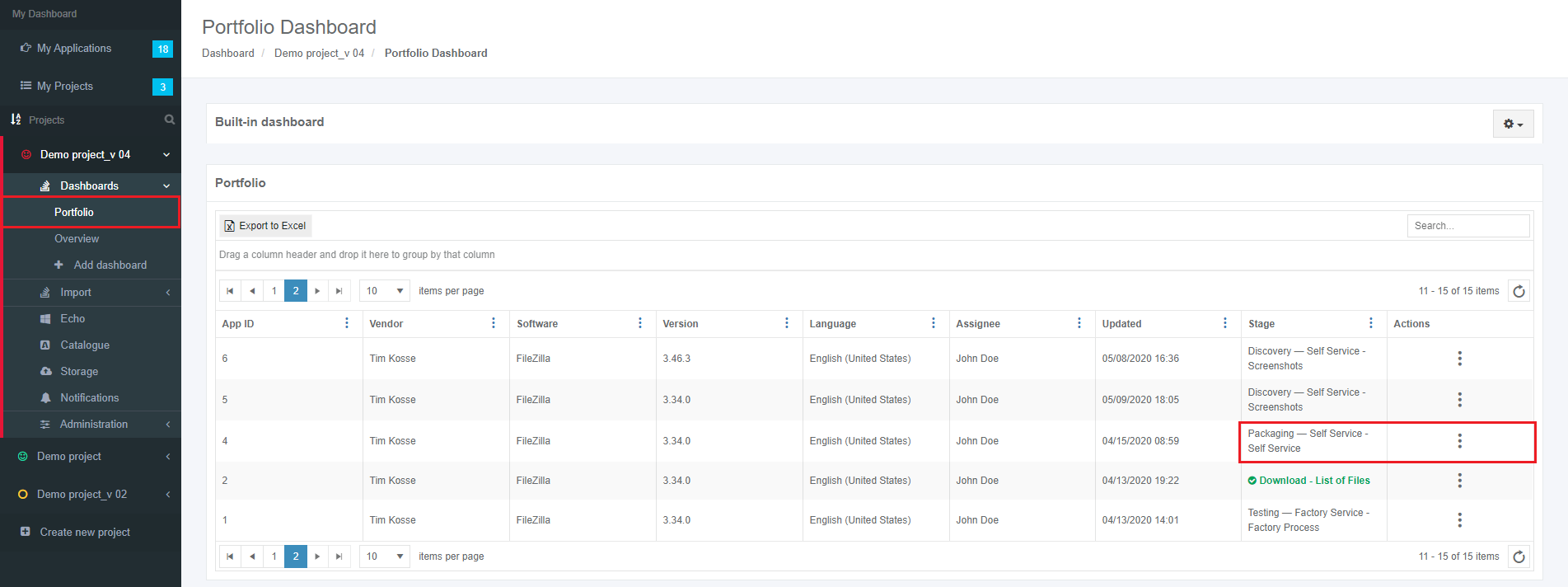](https://docs.apptimized.com/uploads/images/gallery/2020-05/oqh2j8Kgi7cZoYWi-intune_30.png) [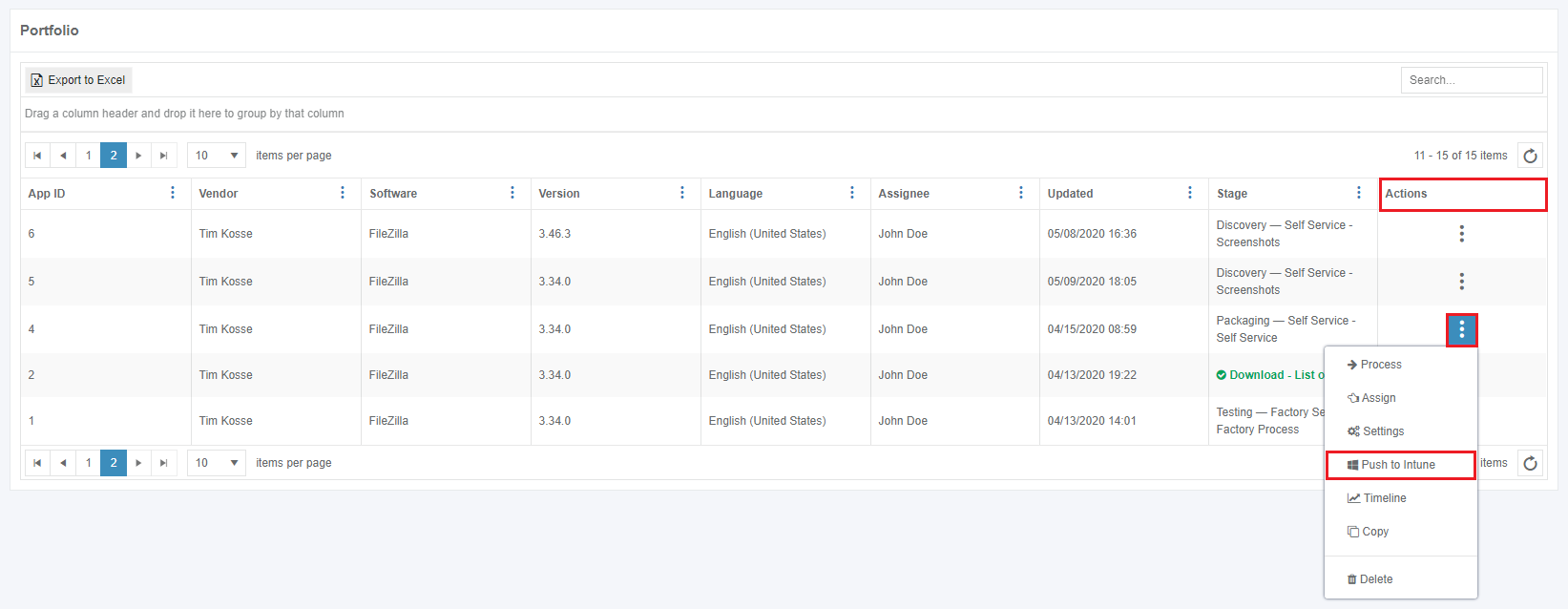](https://docs.apptimized.com/uploads/images/gallery/2020-05/5tOUbKuDalJrAK0I-intune_31.png) Apptimized portal shows the following screen when successful: [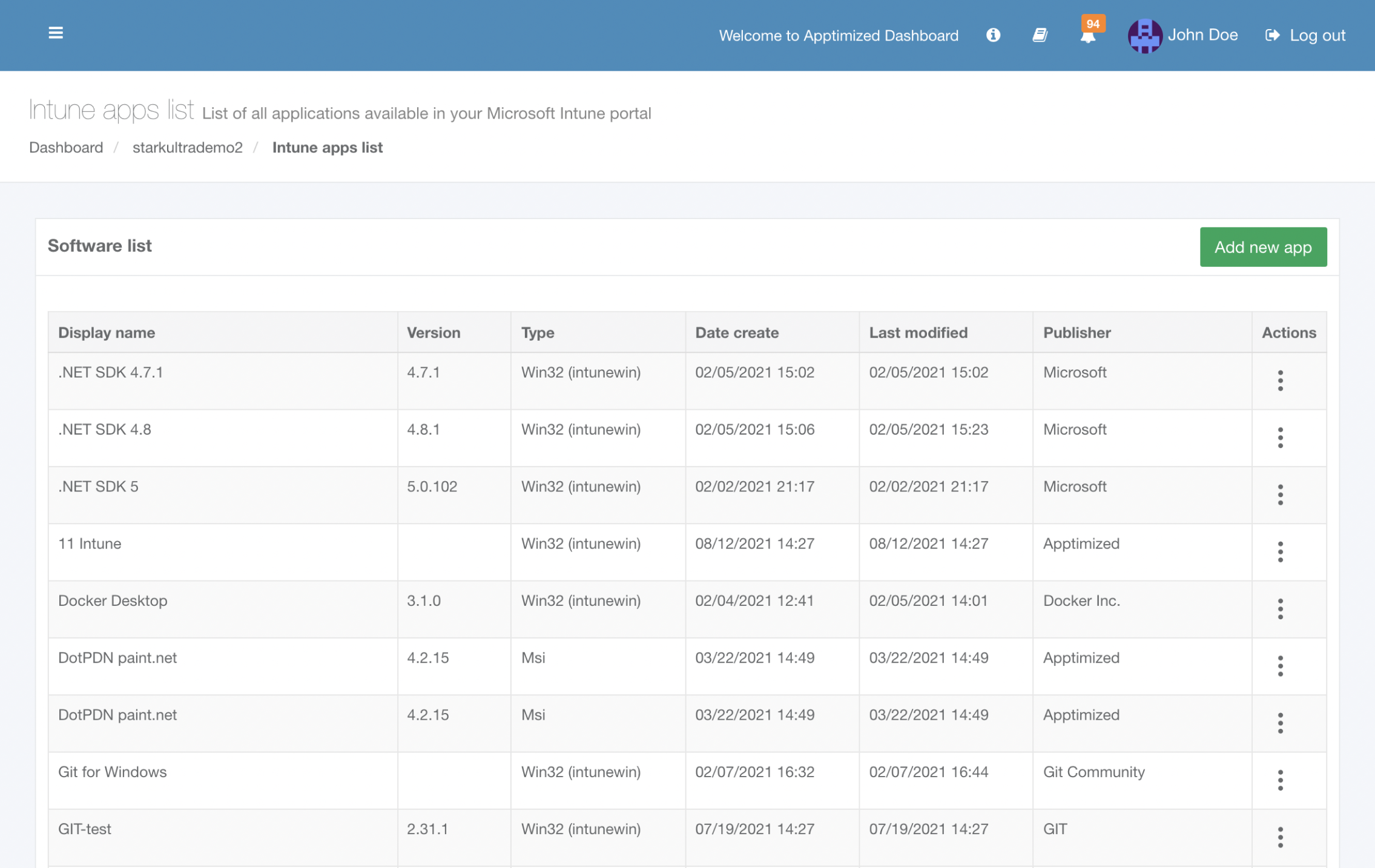](https://docs.apptimized.com/uploads/images/gallery/2021-09/uRNEXyBlmScubEwy-intune_32_2.png) The **Intune apps list** provides a user the information on the full list of applications from the **Microsoft Intune** portal available in the **Apptimized** portal. The **Intune apps list** enables a user to manage applications from the **Microsoft Intune** portal without leaving the **Apptimized** portal. The option to upload the package to the **Microsoft Intune** portal is available under the **Add IntuneWin** button. The application information screen appears when successful: [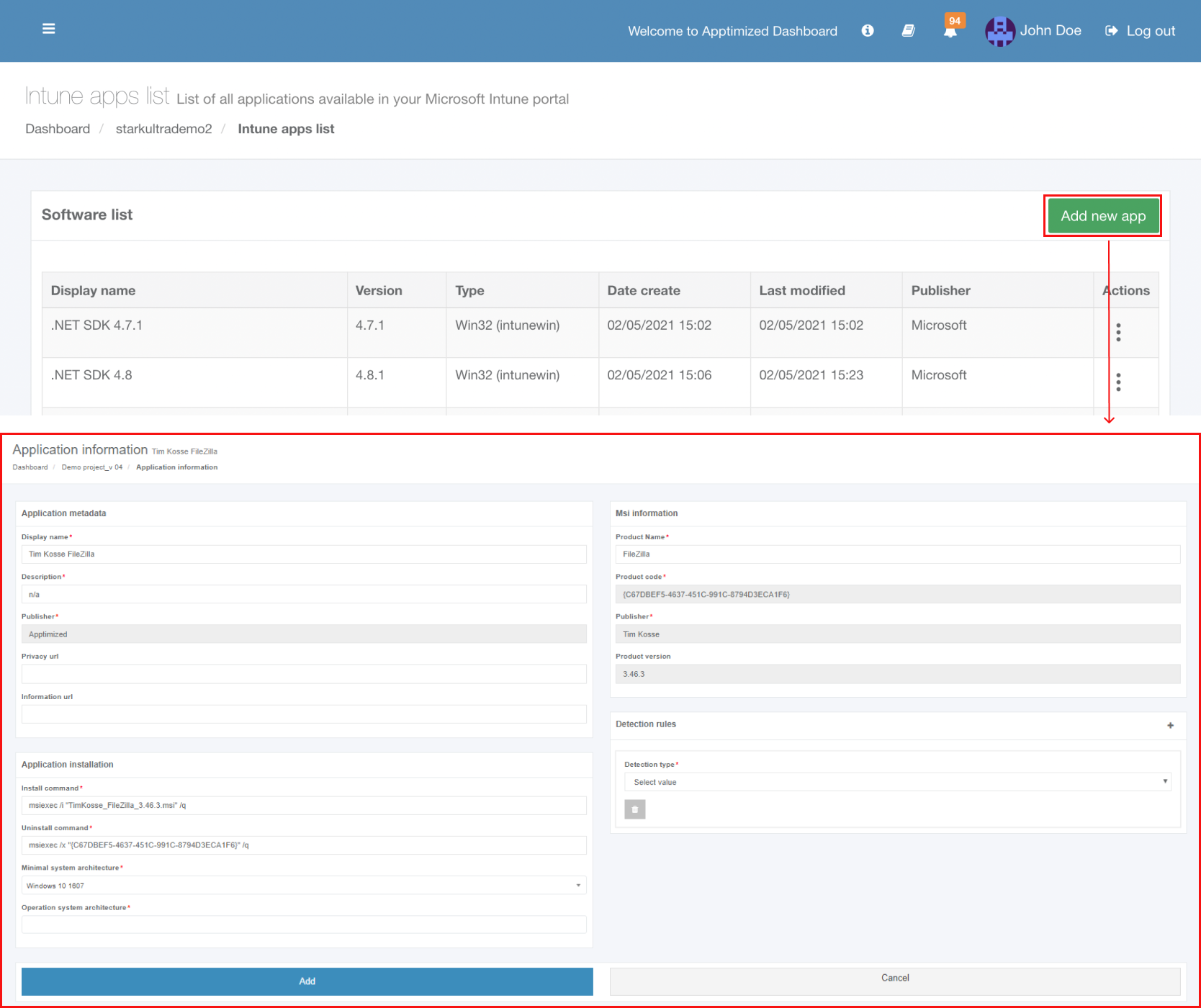](https://docs.apptimized.com/uploads/images/gallery/2021-09/tzGQAIeHL50nEaHk-intune_34_2.png) Table 4. Application settings| **Setting** | **Description** |
| **Application metadata block** | |
| Display name | This setting indicates the application name that will be displayed in the Intune apps list (i.e., **Tim Kosse FileZilla**). A user must make sure that the name of the application is entered as it appears in the Company Portal. All names must be unique. The field comes pre-filled based on the application’s metadata. This field is required. |
| Description | This setting helps the device users to understand what the application is and/or what they can do in the application. This description appears in the company portal. This field is required. |
| Publisher | This setting indicates the name of the developer or the company’s name that distributes the application. This information appears in the company portal. This field is required. |
| Privacy URL | This setting indicates the URL of a website that contains privacy information about the application. The URL appears in the company portal. |
| Information URL | This setting indicates the URL of a website that contains information about the application (I.e., a link to a website or documentation that provides more information about the application). The URL appears in the company portal. |
| **Application installation block** | |
| Install command | This setting configures the application installation command line to install the application (i.e., **msiexec /i "TimKosse\_FileZilla\_3.46.3.msi" /q**). The field comes pre-filled based on the package’s metadata (in the case a package contains the MSI). This field is required. |
| Uninstall command | This setting configures the application uninstallation command line to uninstall the application based on its GUID (i.e., **msiexec /x "{C67DBEF5-4637-451C-991C-8794D3ECA1F6}" /q**). The field comes pre-filled based on the package’s metadata (in the case a package contains the MSI). This field is required. |
| Minimal system architecture | This setting indicates the minimal system architecture requirements. The following options are available: - Windows 10 1607; - Windows 10 1703; - Windows 10 1709; - Windows 10 1803; - Windows 10 1809; - Windows 10 1903. The default value is **Windows 10 1607**. This field is required. |
| Operating system architecture | This setting indicates the operating system architecture type. The following options are available: - 32-bit; - 64-bit. Multiple choice is available. This field is required. |
| Install context | This field indicates the type of execution context the app runs in. The following options are available: - System - User The default value is **System**. |
| **MSI information block** | |
| Product name | This setting indicates the product name that will be displayed n the Microsoft Intune portal (i.e., **FileZilla**). The field comes pre-filled based on the application’s metadata. This field is required. |
| Product code | This setting indicates the product code that is generated automatically using the GUID function (i.e., **{C67BDEF5-4637-451C-661C-8794D3ECA1F6}**). The field comes pre-filled. This field is required. |
| Publisher | This setting indicates the publisher's name that will be displayed in the Microsoft Intune portal (i.e., **Tim Kosse**). The field comes pre-filled based on the application’s metadata. This field is required. |
| Product version | This setting indicates the application version that will be displayed in the Microsoft Intune portal (i.e., **3.46.3**). The field comes pre-filled based on the application’s metadata. |
| **Detection rules block** | |
| Detection type | This setting indicates the detection rule type. The following options are available: - Msi (Verify based on MSI version check); - File (Verify based on file or folder detection, date, version, or size); - Registry (Verify based on value, string, integer, or version). - Script (Verify based on script). |
**Note.** The detection rules are used to detect the presence of the application (i.e., **Microsoft Intune** can determine that the **IntuneWin** package has been installed).
Table 5. Detection rule types| **Detection rule type** | **Description** |
| Msi | [](https://docs.apptimized.com/uploads/images/gallery/2020-05/xOMosFi8LGmF9KdU-intune_35_2.png) The **Product Code** field requires a valid MSI product code for the application. The following options to provide the product code available: - Msi information block > Product code; - To extract from the MSI package. The option to verify the MSI product version in addition to the MSI product code is available under the **Check product version** checkbox. [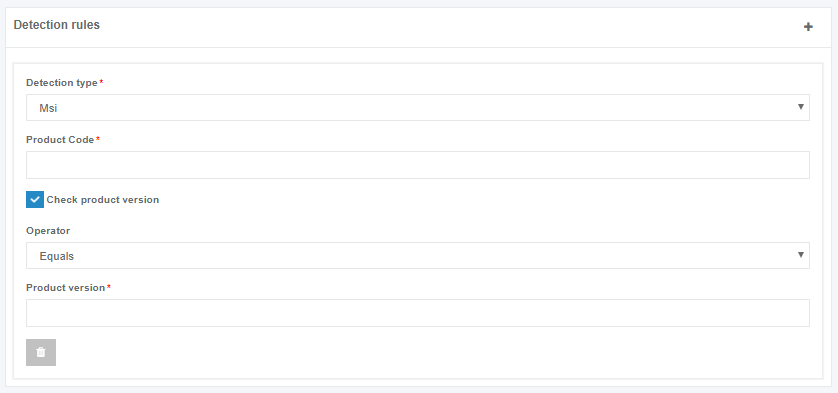](https://docs.apptimized.com/uploads/images/gallery/2020-05/k3bgtY3rzyWQLBE7-intune_35_3.png) The option to set the operator condition rules is available under the **Operator** field. The following options are available: - Equals; - Not equal to; - Greater than or equal to; - Greater than; - Less than or equal to; - Less than. The default value is **Equals**. The **product version** field sets the application version that will be used for applying the operator condition rules. All required fields are marked with an asterisk \*. |
| File | [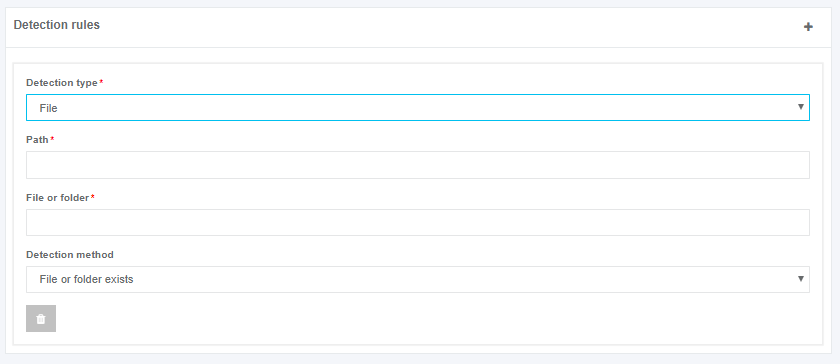](https://docs.apptimized.com/uploads/images/gallery/2020-05/4WA63h3jpWrJjUdS-intune_35_5.png) The **Path** field requires the full path of the folder containing the file or folder to detect. The **File or folder** field requires the file or folder to detect. The **Detection method** field requires the type of detection method used to validate the presence of the application. The following options are available: - Date created; - Date modified; - File or folder exists; - Size in MB; - String (version). The default value is **File or folder exists**. All required fields are marked with an asterisk \*. |
| Registry | [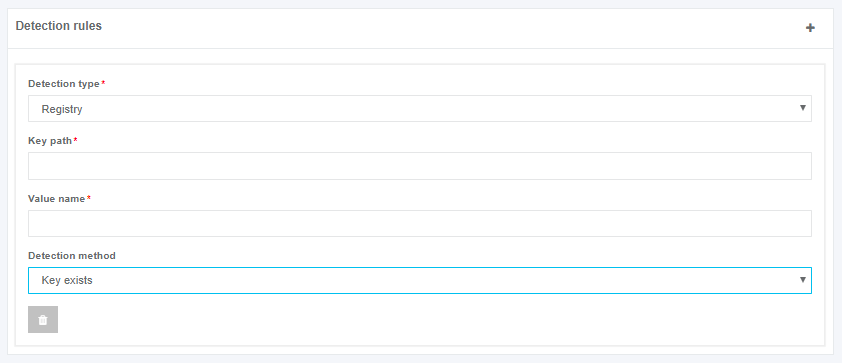](https://docs.apptimized.com/uploads/images/gallery/2020-05/xQ2Q3WinuPziw3Cd-intune_35_7.png) The **Key path** field requires the full path of the registry entry containing the value to detect. The **Value name** field requires the name of the registry value to detect. The **Detection method** field requires the type of detection method used to validate the presence of the application. The following options are available: - Key exists; - Key does not exist; - Integer comparison; - String comparison; - Version comparison. The default value is **Key exists**. All required fields are marked with an asterisk \*. |
| Script | [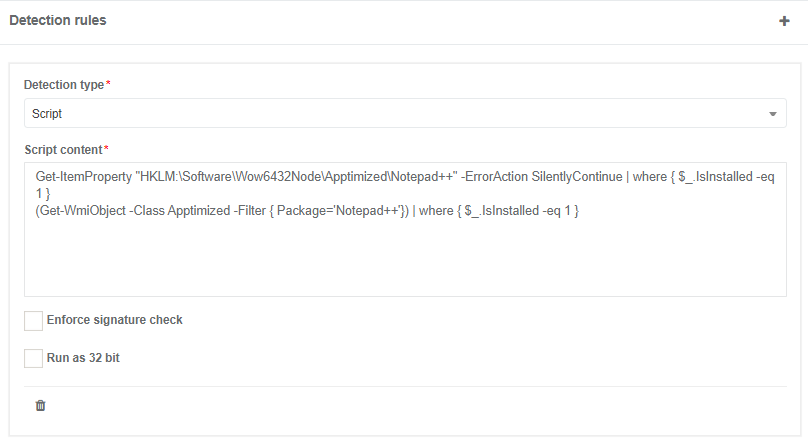](https://docs.apptimized.com/uploads/images/gallery/2021-07/n6qElzAQIUPY77ef-intune_39.png) The **Script content **field requires the full script code containing the PowerShell script to detect app presence The option to reprioritize signature check is available under **Enforce signature check **checkbox The option to run script in 32 bit mode is available under **Run as 32 bit **checkbox. |